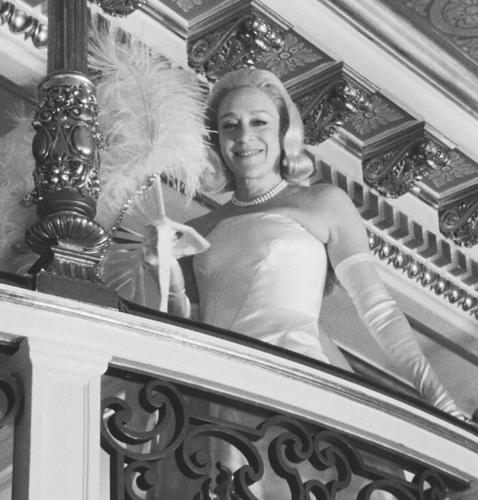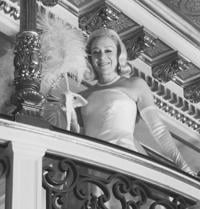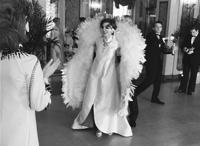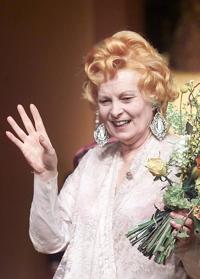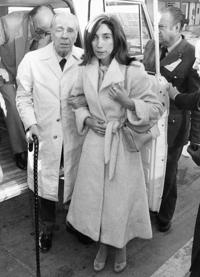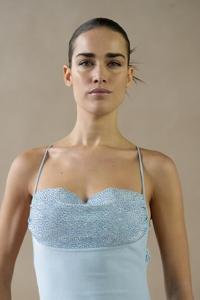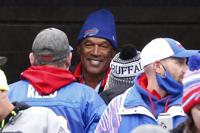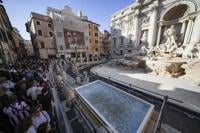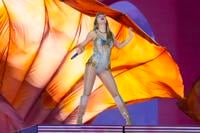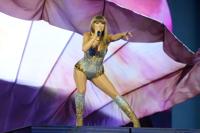NEW YORK (AP) — Executive producer Ryan Murphy is known for creating vivid TV worlds where high drama feels completely normal.
Costume designer and producer Lou Eyrich has helped him bring these worlds alive, and their latest collaboration, “Feud: Capote vs. The Swans,” peeks under the fur coats and behind the giant sunglasses to see the complicated lives of the elite set in 1960s and 1970s New York.
It's the second installment in Murphy’s “Feud” series, and follows from the 1960s through his death in 1984 as he charmed and befriended the upper ranks of Manhattan high society, including women like Babe Paley, C.Z. Guest and Lee Radziwill, whom he nicknamed “the swans.”
Tom Hollander plays Capote, cavorting on the Upper East Side with co-stars Naomi Watts, Diane Lane, Demi Moore, Chloe Sevigny, Molly Ringwald and Calista Flockhart. The show is based on the bestselling book “Capote’s Women: A True Story of Love, Betrayal, and a Swan Song for an Era,” by Laurence Leamer.
It details the lives of the rich and powerful original real housewives of New York. The socialites trusted Capote and let him into their tight circle, only to be betrayed when he exposed their secrets in a fictional magazine piece.
While Capote uncovered the skeletons in their closets, Eyrich uses other closet contents to show the women’s wealth, style and glamour. The design team spent months researching the era.
Watts said Eyrich went to “painstaking lengths” to get it right. “She’s a genius,” Watts told the AP. “It was fun for all of us. We all love a bit of glamour, let’s be honest.”
The series -- available on FX and streaming on Hulu — dropped an episode this week based on Capote’s famous Black and White masquerade ball, where 500 of New York’s VIPs gathered at the Plaza Hotel in 1966 to drink, dance and show off their looks.
Eyrich said that after 24 years of working together, she and Murphy ("American Horror Story," “Pose,” “Ratched”) have their own language, and she knows how to translate his ideas into art.
“Ryan has it all in his head before we even have our first meeting,” she said. “I don’t do boards for him until we meet. A lot of the color palette will come from him usually.”
Once Murphy explained the tone he was going for, Eyrich's team began their research, scouring period fashion magazines so that when a scene takes place in a particular year, they knew which outfits and accessories would work.
“We got lucky finding a lot of great vintage. A lot of it is 40, 50 years old now, so, it’s either faded or missing a piece, belt or jacket or something. So that’s a little frustrating, but we can then use it as a template,” Eyrich said.
Her team created original designs for about half the costumes they couldn’t source.
Though the swans were style icons and wore only the best, it’s interesting to note the absence of brand logos or flashy patterns. The clothes were classic and elegant, with fabulous jewelry, handbags and hats.
Eyrich said Watts, who plays Babe Paley, “got hit the hardest” as the main character besides Capote. She had scores of costume changes — a staggering 160 or so in just the first four episodes — stretching over two decades. Each costume was designed to fit the year, Paley’s personal style and the plot moment.
Watts was a great partner, Erich said: “She wanted to make sure she felt like Babe. I loved the way she would look in the mirror and (say).. ‘I think this is absolutely it.’ That was fun to me.”
Even costumes used only in short scenes or shot from the waist up show attention to detail.
“Some of them would be sitting in a chair, reading a newspaper and you never would see the whole outfit, but we dress it, you know, head-to-toe perfection,” Eyrich said.
“I tend to be a little bit annoying with my detail, especially with tailoring,” she said with a smile. “I could have used another year to really study it all, but you just don’t get the time in TV.”
As for Capote's costumes, Eyrich used them to show how the alcoholic writer was falling apart as the series progresses. While Capote initially wears bow ties and tight suits, he soon moves to turtlenecks and sport coats in the 1970s, paired with bell bottoms and Gucci loafers.
“He became more flamboyant, and then when he started to really become a drunk, things weren’t matched anymore. He didn’t tuck in his shirts... the sweater was buttoned wrong. He wouldn’t bother putting shoes on,” Eyrich said.
For the masquerade ball, Murphy tapped designer to create the main characters’ gowns. He asked Posen to look at the real outfits and heighten them, to create less literal copies and more artful, elevated interpretations.
“Each look we came up with, (we had) this idea of this beautiful, slightly evil menagerie on a pond of different birds,” Posen told the AP. “We’re extended into creature level… like extended reality.”
He took cues from creators “from Jim Henson to Fellini to Zeffirelli, and all these magical moments where reality, surrealism and history come together.”
The end result is over-the-top ensembles incorporating crystals, feathers and elaborate masks. Posen searched for vintage fabrics and accent details.
“They were American or international royalty at that point, and they were the ones who wore and bought high fashion," Posen said.
While the real Paley wore a designer dress with a fur coat to the ball, Posen made adjustments.
“A little fur coat… that’s not enough for an entrance for a contemporary audience that expects a level of wow. So I started building this incredible sculpture of a swan arm, so it looked like she was enveloped in it and opened large scale, and it kind of became this… giant opera coat with a marabou-trimmed collar inside,” Posen said.
Murphy was also specific about jewelry.
“The jewels have to be real… even if they’re a simple pearl with diamonds around it, it’s just gotta really read," Eyrich said. "So I was nervous about that because I didn’t want to be in the business of policing very expensive jewelry, or that my crew on set should be responsible for $34,000 earrings.”
The production hired security to ensure the safety and care of the expensive jewelry, by designers including Verdura, Van Cleef & Arpels, Belperron, and Cartier. Verdura opened its archives and provided a quick education on the jewels the swans owned.
The security guards followed the jewels closely on set, which was a bit of a distraction, Watts said with a laugh. The “big, hulky guys” watching a million-dollar necklace would hover over her during filming. “It was quite funny: ‘Yes, yes, I promise you, I’m not going to run out of here with it!’”
Many of the actors said the high-fashion aesthetic helped inform their characters.
“Top to bottom it really was transformative of… who they were, how they carried themselves,” Moore said.
Ringwald — a vintage clothing lover — called Eyrich “extraordinary.” “I could have spent every day with her going through the wardrobe and hunting and finding. I told her I would be her assistant,” Ringwald said. “I’m obsessed!”
Sevigny credits Eyrich’s “encyclopedic mind” for the historical accuracy and character intention of the clothes.
“If we were doing a scene in the fall of ’77, she would find a suit from a Givenchy show from ’77, very specific,” Sevigny said. “She took everybody’s notes really to heart and she really wanted it to be collaborative. She wanted you to feel glamorous and feel like something fit right. She took a lot of time and care with all of us.”

